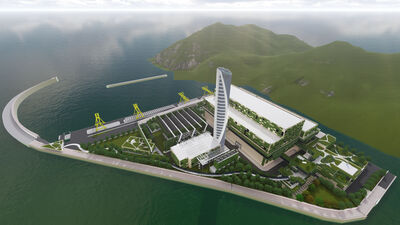Keppel Seghers : Modularisation: The Waste-to-Energy Revolution

Delivery of prefabricated modules to the project site in Hong Kong
- © Keppel SeghersThe global waste crisis is characterised by the increasing volume of municipal solid waste, the limited capacity of landfills and above all, the environmental consequences of landfilling. Today, the world generates more than 2 billion tons of municipal solid waste, and approximately 70% of that waste is sent to landfills [1].
Waste-to-Energy (WtE) technology offers a viable solution to divert non-recyclable waste from landfills and to generate clean energy as well as and reusable materials. As at end 2022, there were more than 2,700 active WtE plants around the world [2]. However, driven by rapid urbanisation and growing populations, the World Bank expects the global amount of solid waste will reach 3.4 billion tons by 2050 [1]. This would require WtE capacities of 850 million annual tons to manage that waste, which is about twice the capacity of today’s WtE assets.
The deployment of WtE plants can face several challenges, such as a lack of specialised local labour, workshops and construction firms, as well as insufficient space for material storage, pre-assemblies, and laydown areas. The inherent complexities of these elements often escalate both the risk and cost of construction, posing significant challenges to the economic viability of new WtE projects. Even when financial projections appear favourable, these factors can still result in cost overruns and substantial delays during project execution.
Modularisation: A Game-Changer
To address these challenges, modularisation has emerged as a game-changing approach. Modularisation is a construction method that involves building parts or entire structures in a fabrication facility and then transporting them to the construction site for assembly.
Critical components of WtE plants that demand the relevant skills, efficiency, and experience for construction are first identified. These typically include the furnace, boiler, flue gas treatment system and turbine, along with all associated electromechanical equipment, instrumentation, piping, cabling, steel structures and insulation. The production of these components poses the greatest risks to cost overruns and construction delays.
The critical components of the plant are then prefabricated and assembled as modules in a controlled environment at an offsite fabrication yard or facility where skilled, efficient and affordable labour is available. This not only enhances efficiency, safety and quality but also reduces construction time and costs compared to conventional onsite construction.
In parallel, the civil and building construction works are executed at the site where the WtE plant will be located. They typically include the ground- and underground works, civil works, roads, weighbridge and waste reception hall, waste bunker and cranes, non-process spaces, utilities, and building services.
The site is also prepared to receive prefabricated modules to minimise integration works and interfaces between the different contractors on site. Once prefabricated, the modules are transported by land or sea to the site where they need to be installed. After installation and integration on site, the WtE plant building is then closed and the commissioning works can start.
Benefits of Modularisation
Modularisation offers numerous benefits that help to address the challenges faced in the WtE deployment.
- Reduces delivery timeline: Offsite fabrication yards often have better access to skilled labour, availability of cranage, workshops, preassembly areas. By freeing up space onsite, civil and building works can proceed more efficiently, reducing interfaces and workspace required between the different contractors and services. Simultaneous works carried out onsite and offsite will speed up project delivery.
- Optimises use of space: Less storage and preassembly areas are needed, reducing the space constraints within site.
- Enhances overall safety: Fabrication in a controlled environment improves job safety and minimises hazards and risks.
- Improves quality: Stringent control measures can be better implemented in a controlled factory environment before delivery.
- Global reach: Prefabricated modules can be transported over long distances, by land and sea, making modular WtE a viable solution for a global reach.
Addressing conditions
While modularisation offers numerous advantages, it is not without its challenges. Some concerns include the potential for transportation delays due to weather conditions and the need for careful planning and coordination between the fabrication yard and the construction site. However, these challenges can be effectively addressed through proper project management and risk mitigation strategies.
The Hong Kong Case Study – Integrated Waste Management Facilities Phase 1 (IWMF1)
Keppel Seghers demonstrated the effectiveness of modularisation with its groundbreaking project in Hong Kong. The world's first modularised WtE plant, IWMF1, is now under construction using prefabricated modules that were assembled at a fabrication yard in Mainland China. Meanwhile, the reclamation of the artificial island and the related civil works for the formation of the work site were carried out concurrently in Hong Kong. The prefabricated modules were then delivered to the site for final assembly. The pictures hereunder illustrate the different sequential phases of the project until today, with the artist’s impression of how the plant will look like when completed.

The Future of Modular WtE
The success of the Hong Kong project demonstrates the potential of modularisation to revolutionise WtE deployment. With advancements in technology and growing demand for sustainable solutions, modular WtE is poised to play a crucial role in addressing the global waste crisis.
By overcoming challenges and harnessing the benefits of modularisation, WtE plants can be built more efficiently, cost-effectively, and in a wider range of locations, contributing to a cleaner and more sustainable future.
Visit our website
Connect with uns on LInkedIn
[1] Worldbank, “WHAT A WASTE 2.0” [Online]. Available here
[2] Ecoprog [Online]. Available here
